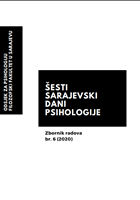Provjera metrijskih karakteristika Skale motivacije za roditeljstvo
Psychometric validation of Parenting Motivation Scale
Author(s): Anela Hasanagić, Almira Isić-ImamovićSubject(s): Individual Psychology, Experimental Pschology, Behaviorism, Methodology and research technology, Pedagogy
Published by: Filozofski fakultet Univerziteta u Sarajevu
Keywords: validity exploration; parenting motivation; factor analysis;
Summary/Abstract: Parenting motivation has been studied recently quite intensively, especially in the context of other factors that determine parental motivation, but also as a predictor of other criteria variables. In Bosnia and Herzegovina, there are number of studies in which Parenting Motivation scale Lacković-Grgin and Vitez (1997) by was used, but this scale was not tested primarily in the context of Bosnia and Herzegovina, on BiH sample, so the aim of this study is to examine the psychometric characteristics of the above mentioned instrument developed ba Lacković-Grgin and Vitez (1997) on the sample of BiH population. An available sample (N=124) consisted out of parents whose children attend one of the preschool institutions in which research took place. The results of the item analysis show the discriminant validity of each item is above the criteria of 0.3, which implies that item reliability is satisfying. The reliability of the whole instrument is α=0.956, and according to particular sub scales it is as follows: altruistic motivation α= 0.869, fatalistic α=0.868, narcissistic α=0.769, instrumental self affirmation α=0.860, instrumental extension of the family α=0.857, instrumental preservation of marriage stability α= 0.892, and instrumental patriotic motivation α= 0.870, which indicates that the instrument has extremely good reliability. The intitial solution of the exploratory factor analysis offered a solution with 12 factors and that explained total of 72.3% of variance. Such solution was not interpretable. The scree plot of this solution indicated the justification for 7 factors. And, at last, interpretable solution was obtained by confirmatory analysis with a fixed number of factors at 7 and Equamax rotation with Kaiser Normalization included, that explained 61,53% of variance. This solution almost completely confirmed the solution offered by authors of the Scale.
Journal: SARAJEVSKI DANI PSIHOLOGIJE: ZBORNIK RADOVA
- Issue Year: 6/2020
- Issue No: 6
- Page Range: 164-186
- Page Count: 23
- Language: Bosnian

